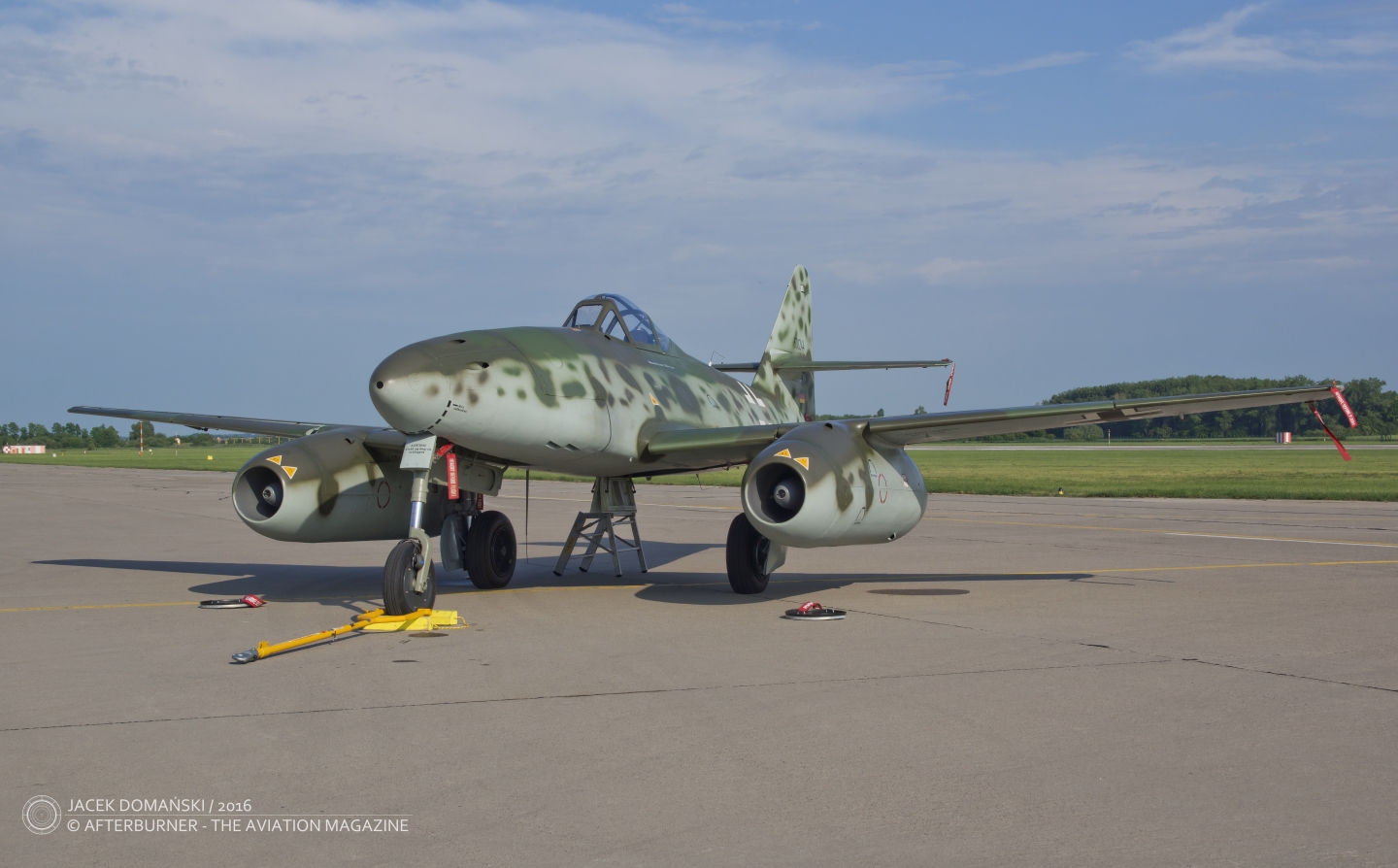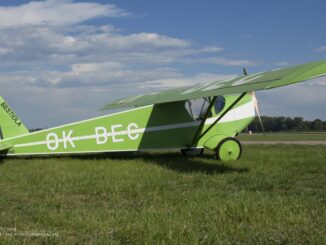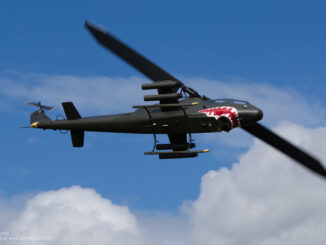
Messerschmitt Me-262A-1C ´Schwalbe´ (replica) D-IMTT, rehearsal for Aviatická pout air show in Pardubice (Czech Republic), May 2016.
Although the idea of jet-powered aeroplane is practically as old as the aircraft itself, the first constructions of lightweight pulsejet engines were just an interesting curiosity, without any practical application.
The first ever pulsejets were patented by French and Russian inventors: Charles de Louvrié (who patented his concept of ´Aeronave´ aircraft in 1863), Nikolai Afanasievich Teleshov (a project of pulsejet engine in 1867) and Viktor V. Karavodin (most probably the first working pulsejet, constructed in 1907). A few further developments of the jet engine and jet powered aircraft were then designed by G. Marconnet, R. Casanova and H. Coandă.
The large-scale development of the jet engine and jet-powered aircraft began in 1930s, with Italy, Germany, United Kingdom and France being at that time the leaders of jet propulsion technology. In 1934, a young German engineer named Hans von Ohain designed his first turbojet engine and then, hired by Heinkel, started to work on further development of his work. In the same year, Secondo Campini in Italy began his project of Campini Caproni C.C.2 jet-powered aircraft and two years later, René Leduc launched the Leduc 010 project – a ramjet powered aeroplane for the French Air Force. In the meanwhile, Frank Whittle, who designed his own jet engine in 1930 but meet no interest in this design at the Air Ministry, was desperately looking for any financing for his project – only in 1936 the company named Power Jets was established, allowing Whittle to continue work on his engine.
Heinkel prototype, designed as He 178 V2 and powered by Ohain´s engine, was ready shortly before the outbreak of the World War II and performed its maiden flight on 27th August 1939. Exactly one year later, on 27th August 1940, the Campini Caproni C.C. 2 took-off for its first flight. In 1941 another Heinkel-manufactured aeroplane, a prototype of He 280 twin-engine jet fighter aircraft, performed its first flight. Whittle´s project, named Gloster E.28/39, had to wait for its maiden flight until 15th May 1941, therefore becoming the fourth flying jet aircraft.
Messerschmitt joined this ´jet race´ in 1938, launching ´Projekt 1065´ – the design of twin-engine jet fighter, led by Waldemar Voight. However, the initial works on that project advanced very slowly, facing several problems with financing, engineering team and engines. The mock-up of the aircraft was ready in March 1940 and the maiden flight of Me 262 was performed as late as July 1942.
Once again, similarly as in 1936, Heinkel and Messerschmitt stood up against each other – Heinkel with second, advanced prototype of He 280 and Messerschmitt with Me 262. Both aircraft were very similar in design and still far away from the final and operational variant but – the same as seven year ago – Willy Messerschmitt managed to convince the Third Reich authorities for choosing his project. On 27th March 1943, just a few days after the first successful flight of He 280 V2, Ernst Heinkel was ordered to abandon this project immediately.
However, even after blocking his direct competitor, Messerschmitt was not able to step up work on Me 262. Still having problems with engines and short supply of strategic material caused a significant delay in development. In addition, both Junkers and BMW engines proposed for new fighter jet had an extremely short life span – 50 and 35 flying hours, respectively.
Finally, on 19th April 1944, the first test unit flying Me 262s (Erprobungskommando 262) was formed and the first ever operational jet fighter has become a fact. Approximately 1,400 aircraft were produced until the end of the war, but there were no more than 200 operational at the same time. The short, but intense, operational career of Me 262 is still analysed by aviation historians, being a subject of many books and other works. However, they mostly agree that – despite being a first sign of revolutionary changes in aviation – Me 262 was not able to have any significant impact on the course of war. Not only being introduced too late and in low amount, but also having constant problems with rough-designed engines and limited operational performance. Nevertheless, being the first, Me 262 became a legend and an icon of the Third Reich´s ´Wunderwaffe´ programme.
After the war, a few Me 262s were captured and evaluated by the Soviets, British and Americans. Approximately a dozen aircraft were completed after the war in Czechoslovakia and operated by the Czechoslovak Air Force (as S-92 and CS-92) until 1951. Regrettably, none of the captured or post-war manufactured Me 262s was preserved in airworthy condition.
The idea of manufacturing the flying reproduction of Me 262 was born at the beginning of 2000s, and shortly after, in 2003 the Texas Airplane Factory and Classic Fighter Industries launched the Me 262 Project. The first aircraft rolled out in 2005, powered by General Electric CJ160 turbojet engines and having the serial number 501241 – the next one after the last Me 262 manufactured in 1945).
Me 262A/B-1c, serial number 501244 is the fourth replica manufactured under the Me 262 Project. The aeroplane can be converted into both A (single-seat) and B (two-seater) variant, and ´c´ in the type description means the CJ160 engines. The aircraft is currently owned by Messerschmitt Stiftung in Manching (Germany) and registered D-IMTT.
A few years ago, Flying Heritage & Combat Armor Museum in Everett (USA) announced the launch of Me 262 restoration project. The aircraft 500453 is currently being restored into the airworthy condition, including the original engines. Works are nearly completed, and it is expected that Me 262 A-1a/U3 would be ready to fly this year.



